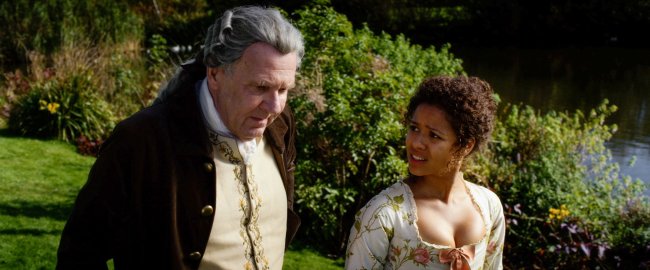Folding fans flutter, bosoms heave above Empire-waisted dresses and class distinctions get in the way of true love.
But in the 18th-century romance “Belle,” the young British aristocrat trying to find her place, in society, and in love, is black, the daughter of a black woman and a white sea captain of noble birth. Still, try to find a review of the new costume romance that doesn’t mention “Jane Austen.”
The comparison to the works of the author of “Emma” and “Pride & Prejudice” may be too obvious to avoid. However, “Belle” is about something Austen rarely came close to addressing: Britain’s contemporaneous debate on the financially important but morally indefensible slave trade.
“It wasn’t something polite people talked about,” Amma Asante, the film’s director says, explaining Austen’s omission of the subject, itself the topic of Austen studies and scholarly debate.
“There’s even a breakfast scene in our movie that demonstrates that, where Lady Mansfield interrupts and says ‘This is a vulgar topic,’” Asante says.
“Austen’s world was more concentrated on the domestic,” adds Gugu Mbatha-Raw, the British actress of mixed race who plays the title role in “Belle.”
“That’s what makes ‘Belle’ so new. We still have Austen’s world, that domestic, marriage market life. It may have the familiar Jane Austen feel of it, but there’s something more at stake here than marrying well.”
 |
Tom Wilkinson (left) as Lord Murray and Gugu Mbatha-Raw as dido in Amma Asante's "Belle". (MT) |
Dido Elizabeth Belle grew up in the home of a very famous uncle. William Murray (played by Tom Wilkinson in the film) was Lord Mansfield and Lord Chief Justice. After raising Belle in his home, Lord Mansfield decided the pivotal case in the history of Britain’s early abolition movement ― the “Zong Massacre” ― in which an insurance company refused to reimburse a slave ship owner for the human cargo he tossed over the side in an effort to commit fraud.
“The Zong Case really does something that no Austen novel or film ever does,” Mbatha-Raw says. “It gives a political context, with the abolition movement as a big part of that.”
The title of Austen’s “Mansfield Park” may not just be a coincidence. As the literary critic Edward Said has pointed out, Austen’s only direct mention of the slave trade comes in that novel, where character Fanny Price “reminds her cousin that after asking Sir Thomas about the slave trade, ‘there was such a dead silence’ that spoke volumes.”
But “Belle” wasn’t filmed as an anecdote to Austen’s concentration on the domestic rather than the worldly. After all, Austen never mentioned the late 18th, early 19th century Napoleonic Wars, any more than the slightly earlier “Belle” focuses on Britain’s losing efforts in the American Revolution, which was going on as the Zong Case was decided and Dido Belle was coming of age and being presented to British society. Asante saw the film as a chance to “blend politics, art and history” into an Austenesque romance.
The film depicts Belle’s life, growing up with a cousin the same age, a white woman also being raised by her aunt and uncle. And its inspiration was a contemporaneous portrait of the two young women made by Johann Zoffany.
“The producer sent me a picture postcard of it, and it drew me in,” Asante says. “I knew how unusual that representation was. People of color were accessories in European portraits of that age. Pets, almost. They were always lower in the frame, looking up in awe to the white protagonist in the painting.
“Dido was higher in the frame, dressed in expensive clothes, grinning and pointing at herself. You ask questions when you see a painting like that.”
The portrait was the main thing the screenwriter, director and star had to go on in creating “Belle” ― “a lovely starting point, for all of us,” Mbatha-Raw says. “It’s so unusual, seeing a black woman, of that time, in a painting with her white counterpart, Elizabeth, her status plainly equal in the composition of it. Her gaze is mischievous. There‘s a brightness to her eyes, looking directly at the viewer.”
There’s documentation of how Dido Belle was not exactly treated as an equal in the household ― an American businessman’s diary noting how Dido wasn’t allowed to dine with guests, but then “he was ‘shocked’ to see ‘a black’ emerging, after dinner, to socialize with the family,” Mbatha-Raw says, with a laugh. But the Mansfields all left Dido money in their wills, “showing the degree of love and affection they had for her,” Asante says.
Asante, who uses lots of close-ups “as sort of my signature, taking you into the mind of the character,” knew she’d found her Belle when she met Mbatha-Raw, best known in this country for a supporting role she played in the Tom Hanks film “Larry Crowne.”
“She has the innate sense of grace that made her seem absolutely at home in this world,” Asante says.
“The corsets help,” jokes Mbatha-Raw. “Your posture, your movement, it makes you fit in.”
“Belle” is earning winning reviews, with Variety’s Justin Chang echoing many in calling the Austen / slave trade topic pairing “a surprisingly elegant and emotionally satisfying fit.”
The director and her star, both British and both black, say they were, in the end, most moved by their love of period romances and the lack of roles for women of color in them. As Asante puts it, “I made this for all the little girls like me, who love a costume drama, who get swept in the romance of it all, but never see themselves reflected on the screen as anything other than a servant.”
By Roger Moore
(McClatchy-Tribune News Service)
(MCT Information Services)








